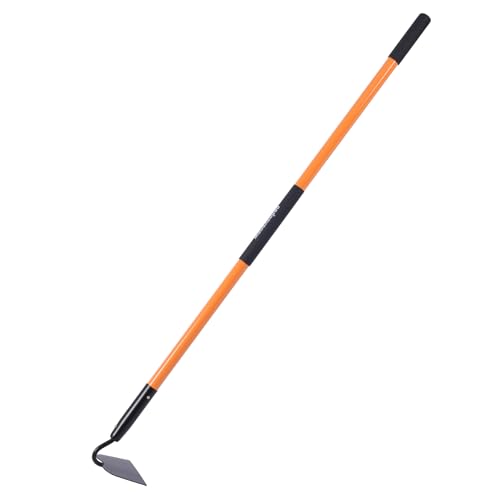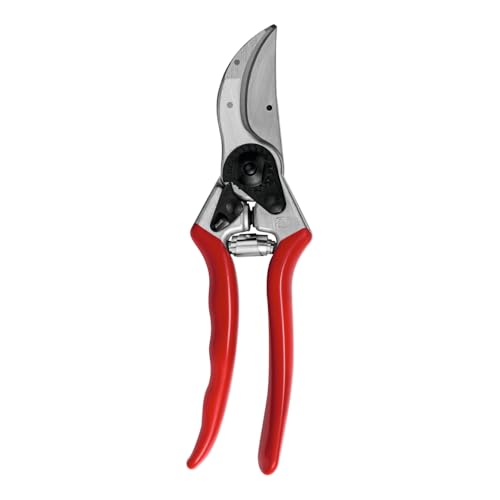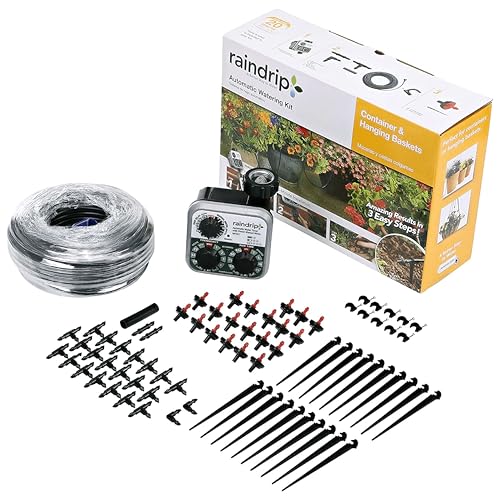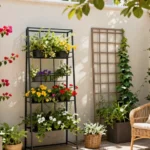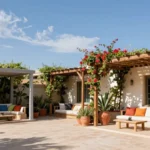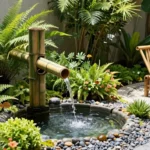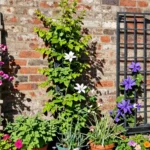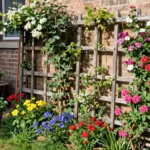Transforming a blank outdoor wall into a living masterpiece doesn’t have to be complicated or expensive. Outdoor plant walls have become one of the hottest landscaping trends, and we’re here to show you why they’re worth every bit of hype they’re getting.
Whether you’re dealing with an unsightly fence, a boring patio wall, or just want to maximize your growing space, vertical gardens offer endless possibilities. We’ve discovered that these living walls don’t just look stunning – they also provide privacy, improve air quality, and can even help reduce energy costs by insulating your home naturally.
From simple trellis systems perfect for beginners to sophisticated hydroponic setups that’ll make your neighbors jealous, we’ll walk you through creative answers that work for every budget and skill level. Ready to turn that empty wall into your garden’s showstopper?
Vertical Garden Towers for Small Spaces
Vertical garden towers maximize growing space in compact areas by stacking plants upward rather than spreading outward. These space-efficient answers work perfectly for patios, balconies, and small yard corners where traditional plant walls might be too large.
Stackable Planter Systems
Stackable planter systems offer the most versatile approach to vertical gardening in tight spaces. We recommend modular designs that allow you to add or remove tiers based on your available space and plant selection. Terra cotta stackable planters work well for herbs like basil, oregano, and thyme, while plastic systems handle heavier plants such as tomatoes and peppers.
Popular stackable options include:
- Ceramic tower planters with built-in drainage systems
- Resin composite stackers that resist weather damage
- Bamboo fiber towers for eco-conscious gardeners
- Metal wire frame systems with removable planting pockets
Most stackable systems accommodate 4-6 plant varieties per tower, making them ideal for creating dedicated herb gardens or colorful flower displays.
DIY PVC Pipe Towers
PVC pipe towers provide an affordable and customizable solution for vertical gardening enthusiasts. We’ve found that 4-inch diameter pipes work best for most plants, while 6-inch pipes accommodate larger root systems for vegetables like lettuce and kale.
Creating your own PVC tower requires these basic materials:
| Component | Size | Purpose |
|---|---|---|
| PVC pipe | 4-6 inches diameter, 5-8 feet tall | Main structure |
| Planting holes | 3-4 inches apart | Plant insertion points |
| End caps | Matching pipe diameter | Top and bottom closure |
| Drainage gravel | 1-2 inches | Water management |
Drill planting holes at 45-degree angles to prevent soil spillage and ensure proper plant positioning. We suggest spacing holes 6-8 inches apart vertically to give each plant adequate growing room.
Rotating Garden Columns
Rotating garden columns ensure all plants receive equal sunlight exposure throughout the day. These innovative systems typically feature a central axis that allows the entire tower to turn, either manually or through automated mechanisms.
Manual rotating systems cost between $150-300 and require daily turning to maintain plant health. Solar-powered rotating towers range from $400-800 but provide consistent plant rotation without manual intervention.
Key benefits of rotating towers include:
- Even light distribution prevents plant leaning and uneven growth
- Better air circulation reduces fungal diseases and pest problems
- Easy maintenance access allows you to reach all plants from one position
- Compact footprint maximizes growing space in minimal ground area
We recommend rotating towers for sun-loving plants such as cherry tomatoes, strawberries, and flowering annuals that benefit from consistent light exposure.
Living Wall Planters Made from Recycled Materials
Recycled materials offer us an eco-friendly foundation for creating stunning vertical gardens. These sustainable approaches transform discarded items into functional plant displays while reducing environmental impact.
Repurposed Pallet Plant Walls
Wooden pallets create some of the most versatile vertical planters we can build. Filling pallet slats with soil transforms these shipping materials into thriving herb gardens, succulent displays, or colorful flower walls.
Budget-conscious gardeners love how pallets revitalize plain fences and boring exterior walls. Customizing these structures with native plants ensures they’ll thrive in local conditions while supporting regional ecosystems.
Shade-loving varieties work perfectly in pallet walls positioned against north-facing surfaces. Plants like hostas, ferns, and begonias flourish in these partially shaded vertical spaces.
Light conditions determine which plants we should choose for our pallet walls. Sun-loving herbs like rosemary and thyme excel in bright locations, while moss and ivy prefer shadier spots.
Upcycled Plastic Bottle Gardens
Plastic bottles transform into creative wall-mounted planters when we cut and arrange them strategically. This upcycling method reduces plastic waste while creating functional growing spaces for small herbs and trailing plants.
Urban environments benefit greatly from these space-saving bottle gardens. Mounting them on balcony railings or exterior walls maximizes growing potential in cramped city spaces.
Patterns emerge when we arrange bottle planters in geometric designs across wall surfaces. Creative arrangements turn functional gardens into artistic installations that catch the eye.
Trailing plants like pothos and string of pearls look spectacular cascading from bottle planters. These flowing displays add movement and visual interest to static wall surfaces.
Old Shoe Organizer Herb Walls
Fabric and plastic shoe organizers repurpose beautifully as pocket herb gardens on exterior walls. Each individual pocket holds small plants like basil, mint, parsley, and cilantro for fresh cooking ingredients.
Installation requires minimal effort since these organizers hang easily on existing hooks or nails. Wall mounting systems distribute weight evenly across multiple attachment points for secure installation.
Soil requirements stay minimal with shoe organizer gardens since each pocket needs only small amounts of growing medium. This lightweight approach works perfectly for renters who can’t make permanent wall modifications.
Vertical space optimization makes shoe organizers ideal for narrow areas like balconies and patios. We can grow dozens of herbs in the same footprint that traditional pots would occupy on the ground.
Modular Green Wall Systems for Easy Installation
We’ve found that modular green wall systems offer the most practical approach for creating stunning outdoor plant walls without extensive construction knowledge. These engineered systems feature interchangeable units that simplify both installation and ongoing maintenance.
Interlocking Panel Designs
Interlocking panels create the foundation for most successful modular green walls we recommend. These panels feature grooves and clips that securely connect both vertically and horizontally, allowing you to scale your wall to any size. The trickle-down watering system built into these designs moves moisture efficiently from top to bottom, reducing your maintenance time significantly.
DIY enthusiasts particularly appreciate how these panels clip together seamlessly without special tools. Each panel supports various plant configurations, making them adaptable to both small patio spaces and expansive outdoor walls. We’ve seen homeowners successfully expand their installations over time by simply adding more interlocking sections.
Magnetic Mounting Options
Magnetic mounting systems provide unmatched flexibility for outdoor plant walls on smooth surfaces. These non-invasive installations eliminate the need for drilling permanent holes, making them perfect for rental properties or temporary displays. You can quickly rearrange plant modules based on seasonal changes or aesthetic preferences.
While less common than traditional panel systems, magnetic mounts excel in situations requiring frequent adjustments. Lightweight plant holders attach securely to metal surfaces, and the portability factor allows you to experiment with different layouts until you find the perfect arrangement.
Expandable Grid Systems
Expandable grids function as customizable frameworks that grow with your plant collection over time. These systems extend both horizontally and vertically, accommodating irregular wall surfaces and evolving design preferences. Individual plant holders or pots attach to grid points, creating ever-changing installations that adapt to your changing needs.
Professional systems like Mobilane’s MobiPanel demonstrate how expandable designs work in practice, featuring interchangeable plant cassettes that fit various wall shapes including curved surfaces. We particularly value how these grids support continuous expansion through additional units, making them cost-effective investments for long-term outdoor gardening projects.
Green Oasis’s POD Living Wall System exemplifies the modular approach with pre-potted plants and quick installation features. Their ongoing maintenance services ensure plant health while the expandable design accommodates growing ambitions for larger wall coverage.
Succulent Walls for Low-Maintenance Beauty
Succulent walls offer the perfect solution for creating stunning outdoor plant displays without the demanding upkeep of traditional gardens. These drought-tolerant beauties create textured, colorful mosaic effects while requiring minimal maintenance and water.
Drought-Resistant Plant Selection
Echeveria varieties form rosette patterns that add architectural interest to vertical displays. These popular succulents come in shades ranging from blue-gray to deep purple and thrive in sunny locations with minimal watering requirements.
Sedum species spread naturally across wall surfaces, creating cascading effects that soften hard edges. Varieties like ‘Dragon’s Blood’ and ‘Autumn Joy’ provide different textures and seasonal color changes while withstanding extended dry periods.
Aloe plants contribute spiky, sculptural elements that contrast beautifully with softer succulent forms. These healing plants store water in their thick leaves, making them incredibly resilient in exposed vertical garden conditions.
Mediterranean herbs like lavender and sage complement succulent walls while adding fragrance and functionality. These aromatic plants share similar water needs and create sensory experiences beyond visual appeal.
Native plant combinations support local biodiversity while ensuring your wall thrives in regional climate conditions. Research indigenous succulents and drought-resistant species that naturally adapt to your area’s rainfall patterns and temperature ranges.
Proper Drainage Considerations
Well-draining soil mixes prevent the waterlogging that kills most succulents in vertical installations. We recommend combining standard potting soil with perlite, coarse sand, and small gravel in equal parts for optimal drainage performance.
Drainage layers at the back of planter pockets create escape routes for excess moisture. Install gravel or crushed stone barriers between the soil and wall structure to prevent water accumulation that leads to root rot.
Vertical structure design must allow water to flow freely through and away from planted areas. Position drainage holes at the bottom of each planting pocket and ensure the wall’s angle promotes natural water movement downward.
Seasonal water management requires adjusting irrigation frequency based on rainfall and temperature changes. Monitor soil moisture levels regularly and reduce watering during cooler months when plant growth slows and water needs decrease.
Seasonal Color Variations
Evergreen succulents provide consistent structure throughout the year while other plants cycle through seasonal changes. Varieties like jade plants and certain sedums maintain their appearance regardless of temperature fluctuations.
Flowering vine additions create bursts of seasonal color when combined strategically with succulent foundations. Morning glories and climbing nasturtiums add temporary blooms without competing for water resources.
Color-changing foliage appears in many succulent varieties that shift from green to red, purple, or bronze during cooler months. Hens and chicks, certain echeverias, and paddle plants demonstrate dramatic seasonal transformations.
Wildflower clusters planted in designated sections bring native beauty and support pollinator populations. Choose drought-tolerant annual flowers that complement your succulent palette while requiring similar care conditions.
Mediterranean herb patterns create aromatic zones that change with harvest cycles and flowering periods. Arrange rosemary, thyme, and oregano in geometric patterns that provide visual interest alongside your succulent displays.
Herb Garden Walls for Culinary Enthusiasts
Culinary enthusiasts can transform their outdoor cooking experience by creating vertical herb gardens that bring fresh flavors within arm’s reach. We’ll explore strategic approaches to designing herb walls that maximize both accessibility and productivity.
Kitchen Garden Accessibility
Positioning herb planters at the right height makes all the difference for daily cooking needs. We recommend mounting modular vertical planter systems between 24 to 48 inches from the ground, ensuring easy harvesting without excessive bending or stretching. Strategic placement near kitchen windows, outdoor cooking areas, or dining patios reduces the time spent walking to distant garden spots while keeping fresh herbs immediately accessible.
Pocket planters work exceptionally well for frequently used herbs like basil, oregano, and chives. We’ve found that installing these systems on walls facing your primary cooking space creates the most efficient workflow. Tiered shelf arrangements allow you to organize herbs by usage frequency, placing daily staples at eye level and specialty herbs on lower or higher tiers.
Companion Planting Strategies
Smart plant pairings enhance both flavor development and natural pest control in vertical herb gardens. We group Mediterranean herbs like rosemary, thyme, and lavender together since they share similar water and sunlight requirements while creating aromatic zones that deter unwanted insects. Basil thrives when planted near tomato plants, improving the flavor of both crops while repelling aphids and whiteflies naturally.
Light requirements guide our vertical arrangement strategy effectively. Sun loving herbs such as oregano and sage occupy the upper portions of walls where they receive maximum exposure, while shade tolerant varieties like mint and parsley flourish in lower sections. We create geometric planting patterns that not only look visually appealing but also optimize growing conditions for each herb variety.
Native herbs integrate seamlessly with Mediterranean species, reducing maintenance while supporting local biodiversity. Patterned groupings of compatible herbs create functional clusters that benefit from shared nutrients and protection from companion plants.
Harvest and Maintenance Tips
Regular harvesting techniques keep herb walls productive throughout the growing season. We trim herbs frequently to encourage bushier growth and prevent flowering, which can diminish flavor intensity in many varieties. Cutting stems just above leaf nodes promotes new growth while maintaining the plant’s shape and vigor.
Watering systems require careful attention to prevent both overwatering and drought stress. We recommend drip irrigation or self watering planters that maintain consistent moisture levels without waterlogging the root systems. These automated answers work particularly well for vertical installations where manual watering can be challenging.
| Maintenance Task | Frequency | Key Benefits |
|---|---|---|
| Harvesting/Pruning | Weekly | Encourages growth, prevents flowering |
| Watering Check | Daily | Maintains optimal moisture |
| Organic Feeding | Monthly | Supports healthy flavor development |
| Pest Inspection | Weekly | Early detection prevents damage |
Seasonal care involves rotating herb varieties to maintain year round harvests. We replace cool weather herbs like cilantro and dill with warm season alternatives such as basil and summer savory as temperatures change. Organic fertilizers designed specifically for herbs provide necessary nutrients without overwhelming plants with excessive nitrogen that can reduce essential oil production and flavor concentration.
Natural pest control methods work best in vertical herb gardens. Neem oil sprays effectively manage common pests while companion planting creates natural deterrent zones that protect vulnerable species from damage.
Trellis-Based Climbing Plant Displays
Trellis systems offer an elegant way to transform bare outdoor walls into stunning vertical gardens that guide climbing plants upward. We’ll explore how attractive trellising can turn any blank exterior surface into a lush living space that adds natural appeal and visual interest to your outdoor areas.
Vine Selection for Different Climates
Climate-exact vine choices determine the success of your trellis wall display and ensure year-round beauty. Climbing fig (Ficus pumila) thrives in zones 9 to 11, rapidly covering vertical surfaces with dense foliage in partial shade conditions. Mediterranean climates benefit from drought-tolerant options like lavender and sage, creating aromatic walls with a distinctive Mediterranean vibe.
Tropical environments call for humidity-loving species such as bromeliads and monstera that add exotic ambiance to your vertical garden. Native plants provide the most sustainable approach, requiring minimal maintenance while ensuring regional compatibility and thriving growth patterns. Shade-loving varieties work perfectly for north-facing walls or areas with limited sunlight exposure.
Flowering vines create natural and inviting aesthetics that change throughout the seasons, adding color bursts and texture variation to your living wall display.
Support Structure Requirements
Trellis frameworks provide essential vertical support for climbing and vining species, requiring weather-resistant materials that can sustain plant weight and growth over time. Lattice structures offer flexible configuration options that accommodate various planting arrangements and design preferences.
Vertical grids enable modular planting configurations that work well for both hanging and potted arrangements, allowing easy customization as your garden evolves. Decorative metal panels combined with leafy greens deliver structural stability while maintaining modern design appeal that complements contemporary outdoor spaces.
| Support Type | Best For | Durability Rating |
|---|---|---|
| Wooden Trellises | Lightweight vines | Medium |
| Metal Panels | Heavy climbing plants | High |
| Lattice Frameworks | Mixed plantings | Medium-High |
| Vertical Grids | Modular systems | High |
Espaliers and screens guide plant growth into formal patterns, creating structured green walls that maintain clean lines and organized appearances throughout the growing season.
Seasonal Growth Patterns
Spring and summer growth spurts characterize most climbing plants, with rapid vertical expansion during warm months followed by dormancy periods in colder seasons. Understanding these cycles helps us plan maintenance schedules and anticipate wall coverage changes throughout the year.
Flowering vines bloom seasonally, adding exact color timing that we can coordinate with other garden elements for maximum visual impact. Evergreen species provide consistent year-round coverage in suitable climates, maintaining wall aesthetics even during winter months.
Mixing plant types with staggered growth and flowering periods ensures continuous interest and greenery, preventing bare patches during transitional seasons. Tropical plants maintain active growth in warm climates, while temperate species follow predictable seasonal rhythms that we can leverage for ever-changing wall displays.
Self-Watering Outdoor Plant Wall Ideas
Modern outdoor plant walls reach new heights of convenience when they incorporate automated watering systems that maintain optimal moisture levels. These innovative irrigation answers eliminate the guesswork from vertical garden care while conserving water and promoting healthier plant growth.
Drip Irrigation Integration
Drip irrigation systems embed discretely into vertical garden frames or planter pockets to deliver water directly to plant roots. This targeted watering approach minimizes water waste while ensuring consistent moisture levels that reduce the risk of plant stress and disease. Professional installers can customize drip systems to match exact watering schedules and volumes that suit different plants’ needs throughout your living wall.
Built-in timers control water flow at predetermined intervals, making it easy to maintain Mediterranean herbs like lavender and sage alongside moisture-loving tropical plants. Multiple zones allow different sections of your plant wall to receive varying amounts of water based on their exact requirements. Pressure-compensating emitters ensure even water distribution across all levels of your vertical garden, preventing dry spots that can damage your investment.
Rain Collection Systems
Rainwater harvesting features transform outdoor plant walls into eco-friendly water conservation systems that collect, filter, and store natural precipitation. These sustainable installations incorporate gutters and downspouts that channel rainfall into storage reservoirs positioned near your vertical garden structure. Filtration systems remove debris and contaminants before the collected water reaches your plants’ root systems.
Storage tanks range from decorative rain barrels to underground cisterns that hold hundreds of gallons for extended dry periods. Gravity-fed systems eliminate the need for electric pumps while providing consistent water pressure to your plant wall’s distribution network. Overflow mechanisms prevent water damage during heavy rainfall events while maximizing your rainwater collection efficiency.
Smart Watering Technology
Advanced outdoor plant walls use soil moisture sensors and smart controllers that monitor plant water needs in real-time throughout the growing season. These automated systems activate drip lines or pumps only when necessary, saving water while ensuring ideal growth conditions for your vertical garden. IoT connectivity enables remote monitoring and adjustment through smartphone apps that send alerts about watering schedules and system maintenance.
Weather integration features automatically adjust watering schedules based on local precipitation forecasts and temperature data. Machine learning algorithms analyze your plants’ water consumption patterns over time to optimize irrigation timing and duration. Battery backup systems ensure your smart watering technology continues operating during power outages, protecting your plant investment from unexpected drought conditions.
Privacy Screen Plant Walls for Outdoor Spaces
Transform your outdoor space into a private sanctuary with strategically designed plant walls that blend natural beauty with functional screening. These living barriers offer an attractive alternative to traditional fencing while creating intimate outdoor environments.
Fast-Growing Plant Options
Climbing vines deliver the quickest coverage for instant privacy transformation. Popular species like Boston ivy and Virginia creeper can cover extensive wall surfaces within a single growing season, reaching heights of 30-50 feet when mature.
Bamboo varieties create modern zen garden aesthetics while providing rapid vertical growth of 2-4 feet annually. Clumping bamboo species like Bambusa multiplex offer dense screening without invasive spreading concerns.
Ornamental grasses such as Japanese forest grass establish striking visual displays with seasonal interest. These plants typically reach 2-3 feet in height and create natural movement that softens hard industry edges.
Flowering vines combine rapid growth with seasonal color bursts throughout the growing season. Morning glories and clematis varieties can climb 10-15 feet annually while producing abundant blooms from spring through fall.
Height and Coverage Considerations
Mature plant dimensions determine the effectiveness of your privacy screen over time. Research each species’ expected height and spread to ensure adequate coverage without overwhelming your space or neighboring properties.
Layered planting arrangements maximize coverage by combining plants of varying heights and growth habits. Position taller specimens like bamboo or climbing vines as backdrop elements, with medium height shrubs and ornamental grasses filling middle zones.
Vertical structure spacing affects both plant health and screening density. Wire mesh panels or lattice frameworks should accommodate 18-24 inch plant spacing for optimal growth and air circulation.
Growth pattern planning prevents coverage gaps by understanding how different plants fill space. Some species grow upward first before branching outward, while others spread horizontally from the base.
Year-Round Screening Answers
Evergreen plant selections maintain consistent privacy throughout all seasons. Broadleaf evergreens like rhododendrons and evergreen climbing vines such as English ivy provide continuous foliage coverage even during winter months.
Native plant integration ensures sustainable year round performance with minimal maintenance requirements. Local species adapt naturally to regional climate patterns and support beneficial wildlife populations.
Mixed seasonal plantings create ever-changing privacy screens that change with the seasons. Combine evergreen backbone plants with deciduous flowering species for visual interest that maintains core screening function.
Low maintenance alternatives include preserved moss walls and high quality artificial plant panels that require no watering or seasonal care. These answers work particularly well in challenging growing conditions or rental properties where permanent installations aren’t feasible.
Artistic Living Walls with Mixed Plant Textures
Creating artistic living walls transforms ordinary outdoor spaces through thoughtful plant combinations that emphasize varied textures and visual depth. We achieve stunning results by blending plants with contrasting characteristics, such as pairing soft, feathery ferns with firm succulents or incorporating flowering vines alongside tropical specimens.
Color Coordination Techniques
Mediterranean color themes create cohesive outdoor plant walls using lavender, olive green, and gray hues that establish calm, unified palettes. We recommend selecting plants with foliage in different green shades while adding colorful flowers or vibrant-leafed varieties like coleus for ever-changing contrast.
Geometric plant arrangements form striking visual effects through color blocks and gradients that create abstract patterns on vertical surfaces. Coordinating planter colors with plant selections or wall surfaces enhances harmony, particularly when using concrete gray, white, or black tones that complement the overall design.
Seasonal color transitions maintain year-round interest by incorporating plants that offer different hues throughout changing seasons. We suggest combining evergreen base plants with flowering varieties that provide color bursts during spring and summer months.
Foliage Shape and Size Combinations
Scale contrast creates compelling visual interest by combining small succulents with larger-leafed plants like monstera or ornamental grasses. Grouping compact species next to trailing vines provides dimensional depth and layered textures that draw the eye upward.
Architectural variety emerges from mixing plants with diverse leaf shapes including spiky, rounded, and feathery forms that add structural complexity. We position tall, upright plants to frame wall edges while filling central areas with medium and low-height specimens for tiered effects.
Textural blending incorporates climbing vines such as flowering wine varieties that add natural grace and vertical flow between planted sections. Tropical plants like bromeliads introduce exotic textures that enliven spaces while maintaining balance with more traditional foliage choices.
Seasonal Interest Planning
Year-round structure requires incorporating evergreens and ornamental grasses that provide winter texture when flowering plants enter dormancy. We prioritize native and drought-tolerant species for sustainable greenery that adapts to local climate conditions without extensive maintenance.
Flowering cycles ensure continuous color by selecting plants with staggered bloom times throughout growing seasons. Spring wildflowers and summer flowering vines create vibrant displays, while preserved moss walls offer consistent texture without seasonal fluctuations.
Light adaptation accommodates different sunlight conditions by choosing shade-loving species for darker wall areas and sun-tolerant varieties for bright exposures. We plan maintenance schedules around seasonal growth patterns to ensure walls remain vibrant and captivating through all weather conditions.
Budget-Friendly DIY Plant Wall Projects
Creating stunning outdoor plant walls doesn’t require a massive investment or professional installation. We’ll explore practical approaches that transform bare walls into beautiful vertical gardens while keeping costs minimal.
Cost-Effective Material Sourcing
Reclaimed wood and pallets offer our most economical foundation for vertical garden construction. We can source these materials from local businesses, construction sites, or online marketplaces at significantly reduced prices compared to new lumber. Wooden pallets work exceptionally well as ready-made planters that simply need mounting and soil filling.
Plastic containers and gutters provide lightweight, weather-resistant alternatives for wall-mounted planters. Old gutters from home renovation projects create perfect linear planters when sealed at the ends and mounted horizontally. Tin cans, plastic bottles, and food containers transform into quirky planters with simple drainage hole modifications.
Local nursery partnerships help us maximize our plant budget through bulk purchasing and seasonal sales. We recommend starting plants from cuttings whenever possible, as this approach costs virtually nothing while providing identical genetic material to expensive nursery plants. Many gardening communities also organize plant swaps where we can trade varieties without spending money.
Simple irrigation components like drip irrigation kits designed for vertical gardens eliminate ongoing maintenance costs while ensuring plant health. Basic DIY watering systems using plastic tubing and gravity feed mechanisms cost less than $20 and serve multiple planter installations.
Simple Construction Methods
Direct wall mounting provides our most straightforward installation approach using basic screws and wall anchors appropriate for the underlying surface material. We attach wooden pallets or custom planter boxes directly to exterior walls without complex framework requirements. This method works particularly well for lightweight containers and herb gardens.
Wire mesh and grid systems support climbing plants with minimal structural investment. Sturdy metal grids or galvanized wire mesh create excellent support frameworks for ivy, jasmine, or clematis while requiring only basic mounting hardware. These systems distribute plant weight evenly across the wall surface.
Modular pocket systems using felt or fabric planters offer maximum flexibility with simple hanging installation. We can arrange these lightweight modules in various patterns without permanent wall modifications, making them perfect for rental properties. The fabric naturally drains excess water while maintaining soil moisture.
Essential drainage planning prevents water damage and plant root rot through strategic hole placement in all containers. We drill 1/4 inch holes every 6 inches along planter bottoms, ensuring proper water flow without soil loss. Adding gravel layers at container bottoms further improves drainage performance.
Maintenance-Light Plant Choices
Native plant selections dramatically reduce our ongoing care requirements since these species naturally thrive in local climate conditions. Native plants require less frequent watering, resist local pests more effectively, and adapt to seasonal temperature variations without intervention. We recommend researching local extension office plant lists for the most suitable varieties.
Succulent and cacti varieties offer unmatched drought resistance while providing striking visual appeal through diverse shapes and colors. These plants store water in their tissues, requiring watering only every 2-3 weeks during growing seasons. Popular low-maintenance options include jade plants, hens and chicks, and barrel cacti.
Shade tolerant species excel in less sunny outdoor wall locations where many plants struggle to establish. Hostas, ferns, and begonias thrive with limited direct sunlight while maintaining attractive foliage throughout growing seasons. These plants typically require less frequent watering than sun-loving alternatives.
Culinary herbs like rosemary, thyme, and oregano combine practical utility with minimal care requirements. These Mediterranean herbs tolerate drought conditions, resist most pests naturally, and provide fresh ingredients for cooking. Their aromatic qualities also help deter unwanted insects from garden areas.
Slow growing ground covers minimize pruning and trimming maintenance while providing consistent visual coverage. Creeping Jenny, sweet woodruff, and moss varieties spread gradually without overwhelming neighboring plants or requiring frequent management. These selections maintain their appearance with seasonal cleanup only.
Conclusion
Creating your own outdoor plant wall doesn’t have to be complicated or expensive. We’ve shown you that with the right approach and materials you can transform any blank wall into a stunning vertical garden that suits your space and budget.
Whether you choose a simple trellis system with climbing vines or invest in a sophisticated modular design these living walls offer incredible benefits. They’ll improve your outdoor air quality provide fresh herbs for your kitchen and create the privacy you’re looking for.
The key is starting with what works for your exact situation. Pick plants that thrive in your climate use materials you can easily maintain and don’t be afraid to experiment with different arrangements as your garden grows and evolves over time.
Frequently Asked Questions
What are the main benefits of outdoor plant walls?
Outdoor plant walls offer enhanced aesthetics by transforming blank walls into beautiful vertical gardens. They provide increased privacy, improve air quality, and can potentially reduce energy costs. These living walls maximize growing space in small areas while creating attractive natural barriers that serve both functional and decorative purposes.
What materials do I need for a DIY PVC pipe tower garden?
For a DIY PVC pipe tower, you’ll need PVC pipes, drainage holes, caps, potting soil, and your chosen plants. Basic tools include a drill for creating planting holes and drainage, PVC cement for connections, and mounting hardware if wall-mounting. This affordable solution offers customizable vertical growing space for various plant types.
How do I create a succulent wall that requires minimal maintenance?
Choose drought-tolerant succulents like Echeveria and Sedum that thrive in sunny locations. Use well-draining soil mixes and ensure proper drainage layers to prevent waterlogging. Position the wall in a location with adequate sunlight and water sparingly. Succulents create colorful mosaic effects while requiring minimal care and watering.
What’s the best height for vertical herb gardens?
Position herb planters between 24 to 48 inches high for easy harvesting and maintenance. This height range allows comfortable access for regular harvesting, watering, and care without straining. Consider placing herb walls near cooking areas for convenient access while ensuring adequate sunlight exposure for optimal growth.
How do self-watering systems work for plant walls?
Self-watering systems use drip irrigation to deliver water directly to plant roots, maintaining optimal moisture levels automatically. They can integrate rain collection systems for eco-friendly irrigation and smart technology with soil moisture sensors. These systems reduce maintenance while ensuring consistent watering for healthier plant growth.
What are the fastest-growing plants for privacy screen walls?
Fast-growing options include climbing vines, bamboo, and ornamental grasses that provide quick coverage. Evergreen selections like ivy or climbing fig offer year-round screening. Consider layered planting arrangements with different heights and textures to maximize privacy while creating an attractive natural barrier that grows rapidly.
Can I create a plant wall on a tight budget?
Yes, use cost-effective materials like reclaimed wood, pallets, plastic containers, or gutters. Simple construction methods include direct wall mounting and wire mesh systems. Choose low-maintenance plants like natives, succulents, or herbs that require minimal care. These budget-friendly approaches can create stunning vertical gardens without significant investment.
How do I maintain proper drainage in vertical gardens?
Use well-draining soil mixes and create drainage layers at the bottom of planters. Drill adequate drainage holes in containers and ensure water can flow freely. For wall-mounted systems, angle planters slightly to prevent water accumulation. Proper drainage prevents root rot and maintains healthy plant growth in vertical arrangements.
What climbing plants work best for trellis systems?
Choose climbing plants based on your climate: climbing fig for warmer zones, drought-tolerant lavender for Mediterranean climates, or hardy vines for cooler areas. Consider seasonal growth patterns and maintenance requirements. Support structures should match plant weight and growth habits, with materials like wood, metal, or lattice frameworks providing adequate support.
How do I coordinate colors and textures in artistic living walls?
Use Mediterranean color themes with complementary plant combinations and geometric arrangements for visual impact. Plan seasonal color transitions and combine different foliage shapes for year-round interest. Consider light adaptation needs and maintenance schedules to ensure vibrant displays. Layer plants with varying textures and colors to create depth and visual appeal.













